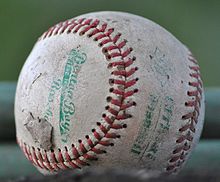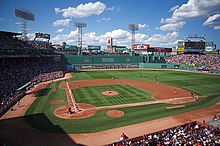User:Boy.pockets/Sandbox
Distinctive elements[edit]
Baseball has certain attributes that set it apart from the other popular team sports in the countries where it has a following, games such as American and Canadian football, basketball, ice hockey, and soccer. All of these sports use a clock; in all of them, play is less individual and more collective; and in none of them is the variation between playing fields nearly as substantial or important. The comparison between cricket and baseball demonstrates that many of baseball's distinctive elements are shared in various ways with its cousin sport.
No clock to kill[edit]

In clock-limited sports, games often end with a team that holds the lead killing the clock rather than competing aggressively against the opposing team. In contrast, baseball has no clock; a team cannot win without getting the last batter out and rallies are not constrained by time. At almost any turn in any baseball game, the most advantageous strategy is some form of aggressive strategy.[1] In contrast, again, the clock comes into play even in the case of multi-day Test and first-class cricket: the possibility of a draw often encourages a team that is batting last and well behind to bat defensively, giving up any faint chance at a win to avoid a loss.[2] Baseball offers no such reward for conservative batting.
While nine innings has been the standard since the beginning of professional baseball, the duration of the average major league game has increased steadily through the years. At the turn of the twentieth century, games typically took an hour and a half to play. In the 1920s, they averaged just less than two hours, which eventually ballooned to 2:38 in 1960.[3] By 1997, the average American League game lasted 2:57 (National League games were about 10 minutes shorter—pitchers at the plate making for quicker outs than designated hitters).[4] In 2004, Major League Baseball declared that its goal was an average game of merely 2:45.[3] The lengthening of games is attributed to longer breaks between half-innings for television commercials, increased offense, more pitching changes, and a slower pace of play with pitchers taking more time between each delivery, and batters stepping out of the box more frequently.[3][4] Other leagues have experienced similar issues. In 2008, Nippon Professional Baseball took steps aimed at shortening games by 12 minutes from the preceding decade's average of 3:18.[5]
Individual focus[edit]
For a team sport, baseball places individual players under unusual scrutiny and pressure. In 1915, a baseball instructional manual pointed out that every single pitch, of which there are often more than two hundred in a game, involves an individual, one-on-one contest: "the pitcher and the batter in a battle of wits".[6] Contrasting the game with both football and basketball, scholar Michael Mandelbaum argues that "baseball is the one closest in evolutionary descent to the older individual sports".[7] Pitcher, batter, and fielder all act essentially independent of each other. While coaching staffs can signal pitcher or batter to pursue certain tactics, the execution of the play itself is a series of solitary acts. If the batter hits a line drive, the outfielder is solely responsible for deciding to try to catch it or play it on the bounce and for succeeding or failing. The statistical precision of baseball is both facilitated by this isolation and reinforces it. As described by Mandelbaum,
It is impossible to isolate and objectively assess the contribution each [football] team member makes to the outcome of the play.... [E]very basketball player is interacting with all of his teammates all the time. In baseball, by contrast, every player is more or less on his own.... Baseball is therefore a realm of complete transparency and total responsibility. A baseball player lives in a glass house, and in a stark moral universe.... Everything that every player does is accounted for and everything accounted for is either good or bad, right or wrong.[8]
Cricket is more similar to baseball than many other team sports in this regard: while the individual focus in cricket is mitigated by the importance of the batting partnership and the practicalities of tandem running, it is enhanced by the fact that a batsman may occupy the wicket for an hour or much more. There is no statistical equivalent in cricket for the fielding error and thus less emphasis on personal responsibility in this area of play.[9]
Uniqueness of each baseball park[edit]
Unlike those of most sports, baseball playing fields can vary significantly in size and shape. While the dimensions of the infield are specifically regulated, the only constraint on outfield size and shape for professional teams following the rules of Major League and Minor League Baseball is that fields built or remodeled since June 1, 1958, must have a minimum distance of 325 feet (99 m) from home plate to the fences in left and right field and 400 feet (122 m) to center.[10] Major league teams often skirt even this rule. For example, at Minute Maid Park, which became the home of the Houston Astros in 2000, the Crawford Boxes in left field are only 315 feet (96 m) from home plate.[11] There are no rules at all that address the height of fences or other structures at the edge of the outfield. The most famously idiosyncratic outfield boundary is the left-field wall at Boston's Fenway Park, in use since 1912: the Green Monster is 310 feet (94 m) from home plate down the line and 37 feet (11 m) tall.[12]

Similarly, there are no regulations at all concerning the dimensions of foul territory. Thus a foul fly ball may be entirely out of play in a park with little space between the foul lines and the stands, but a flyout in a park with more expansive foul ground.[13] A fence in foul territory that is close to the outfield line will tend to direct balls that strike it back toward the fielders, while one that is farther away may actually prompt more collisions, as outfielders run full speed to field balls deep in the corner. These variations can make the difference between a double and a triple or inside-the-park home run.[14] The surface of the field is also unregulated. While the image to the left shows a traditional field surfacing arrangement (and the one used by virtually all MLB teams with naturally surfaced fields), teams are free to decide what areas will be grassed or bare.[15] Some fields—including several in MLB—use an artificial surface, such as AstroTurf. Surface variations can have a significant effect on how ground balls behave and are fielded as well as on baserunning. Similarly, the presence of a roof (seven major league teams play in stadiums with permanent or retractable roofs) can greatly affect how fly balls are played.[16] While football and soccer players deal with similar variations of field surface and stadium covering, the size and shape of their fields are much more standardized. The area out-of-bounds on a football or soccer field does not affect play the way foul territory in baseball does, so variations in that regard are largely insignificant.[17]
These physical variations create a distinctive set of playing conditions at each ballpark. Other local factors, such as altitude and climate, can also significantly affect play. A given stadium may acquire a reputation as a pitcher's park or a hitter's park, if one or the other discipline notably benefits from its unique mix of elements. The most exceptional park in this regard is Coors Field, home of the Colorado Rockies. Its high altitude—5,282 feet (1,610 m) above sea level—is responsible for giving it the strongest hitter's park effect in the major leagues.[18] Wrigley Field, home of the Chicago Cubs, is known for its fickle disposition: a hitter's park when the strong winds off Lake Michigan are blowing out, it becomes more of a pitcher's park when they are blowing in.[19] The absence of a standardized field affects not only how particular games play out, but the nature of team rosters and players' statistical records. For example, hitting a fly ball 330 feet (100 m) into right field might result in an easy catch on the warning track at one park, and a home run at another. A team that plays in a park with a relatively short right field, such as the New York Yankees, will tend to stock its roster with left-handed pull hitters, who can best exploit it. On the individual level, a player who spends most of his career with a team that plays in a hitter's park will gain an advantage in batting statistics over time—even more so if his talents are especially suited to the park.[20]
Table[edit]
| Heading | ||
|---|---|---|
| one | two | three |
| four | five | six |
Other[edit]
This is a test :)
<dpl> category = Teabag_Recycler namespace = User </dpl>
Members[edit]
- pockets
- nakato
- robgel
http://www.mediawiki.org/wiki/Extension:DynamicPageList
Expertise[edit] |
Envolvement[edit] |
|---|---|
High[edit]
Mediam[edit]
Csual[edit]
|
Sponsor[edit]
Orgoniser[edit]
High[edit]
Medium[edit]
Casual[edit]
|
generic discussion page: Discussion
link to linking to images http://www.mediawiki.org/wiki/Help:Linked_images#Site_CSS
Image Link extensions: http://www.mediawiki.org/wiki/Manual:Linked_images#Via_extensions
This is an example of an image with a link
http://fc05.deviantart.com/fs45/f/2009/136/8/5/Meeting_Place_by_GideonLucent.jpg
http://en.wikipedia.org/wiki/Wikipedia:Editor%27s_index_to_Wikipedia http://en.wikipedia.org/wiki/Wikipedia:Layout
- ^ Mount, Nicholas James, "Team Sports", in Encyclopedia of Time, ed. Samuel L. Macey (Taylor & Francis, 1994), pp. 588–590: p. 590.
- ^ Eastaway, Rob, What Is a Googly?: The Mysteries of Cricket Explained (Anova, 2005), p. 134.
- ^ a b c Bodley, Hal (February 26, 2004). "Baseball Wants Just a Few More Minutes". USA Today. Retrieved 2009-02-03.
- ^ a b Greenfield, Jeff (July 13, 1998). "Midnight Baseball". Time. Retrieved 2009-02-03.
- ^ "Japan's Pro Baseball Teams Start Eco-Project to Cut Energy Use by 6%". Japan for Sustainability. July 13, 2008. Retrieved 2009-02-18.
- ^ Clarke and Dawson (1915), p. 48.
- ^ Mandelbaum (2005), p. 55.
- ^ Mandelbaum (2005), pp. 55–57.
- ^ Morton, Richard, "Baseball in England", Badminton Magazine, August 1896, pp. 157–158: "The scoring is one of the most interesting features in this new importation from America [baseball]. Every detail of play is recorded, and a man's mistakes are tabulated as well as his successes.... A line in a cricket score may read, 'Lockwood, caught Stoddart, bowled J. T. Hearne; 30.'... [T]here is so much that is left out! There is no mention of the fact that O'Brien missed Lockwood before he had scored, and that somebody else failed to take a chance when his score was ten. These are items that go to make cricket history; but there is no record of them in the analysis.... The man who catches a ball is thought worthy of mention, but the man who muffs one does not suffer by publicity."
- ^ "Official Rules/1.00—Objectives of the Game. (Rule 1.04a)" (PDF). Major League Baseball. Retrieved 2009-02-02.
- ^ Nightengale, Bob (August 20, 2008). "No. 8: Out in Left Field in Houston's Crawford Boxes". USA Today. Retrieved 2009-02-17.
- ^ Powers (2003), p. 85.
- ^ Powers (2003), p. 219.
- ^ Puhalla, Krans, and Goatley (2003), p. 198; Shaikin, Bill (May 27, 2006). "Guerrero Becomes Mr. Inside". Los Angeles Times. Retrieved 2009-02-17.
- ^ "Official Rules/1.00—Objectives of the Game. (Rule 1.04)" (PDF). Major League Baseball. Retrieved 2009-02-02.
- ^ Shaikin, Bill (October 8, 2002). "No Fly Ball Routine in Dome". Los Angeles Times. Retrieved 2009-02-17.
- ^ Puhalla, Krans, and Goatley (2003), p. 207.
- ^ Keri (2007), pp. 295–301.
- ^ Gilbert, Steve (September 30, 2008). "Wrigley's Winds Don't Rattle Lowe". Major League Baseball. Retrieved 2009-02-17.
- ^ Sheinin, Dave (March 26, 2008). "After Move, a Breaking In Process". Washington Post. Retrieved 2009-02-17. See also Powers (2003), p. 85.

